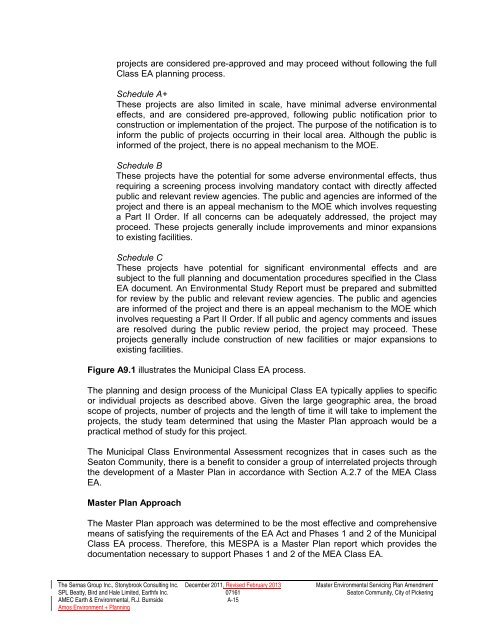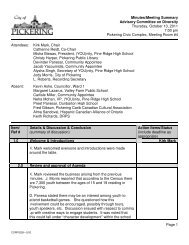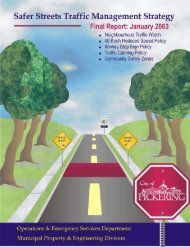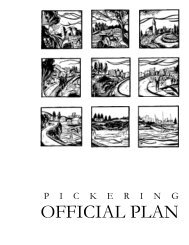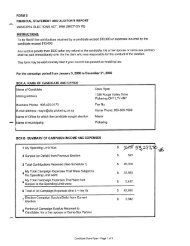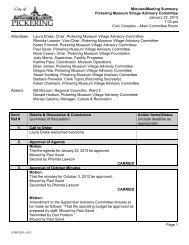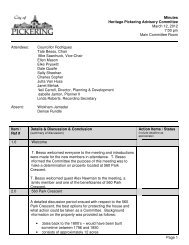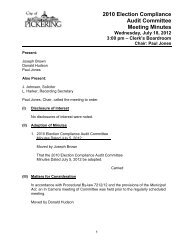Chapter A - Introduction - City of Pickering
Chapter A - Introduction - City of Pickering
Chapter A - Introduction - City of Pickering
You also want an ePaper? Increase the reach of your titles
YUMPU automatically turns print PDFs into web optimized ePapers that Google loves.
projects are considered pre-approved and may proceed without following the full<br />
Class EA planning process.<br />
Schedule A+<br />
These projects are also limited in scale, have minimal adverse environmental<br />
effects, and are considered pre-approved, following public notification prior to<br />
construction or implementation <strong>of</strong> the project. The purpose <strong>of</strong> the notification is to<br />
inform the public <strong>of</strong> projects occurring in their local area. Although the public is<br />
informed <strong>of</strong> the project, there is no appeal mechanism to the MOE.<br />
Schedule B<br />
These projects have the potential for some adverse environmental effects, thus<br />
requiring a screening process involving mandatory contact with directly affected<br />
public and relevant review agencies. The public and agencies are informed <strong>of</strong> the<br />
project and there is an appeal mechanism to the MOE which involves requesting<br />
a Part II Order. If all concerns can be adequately addressed, the project may<br />
proceed. These projects generally include improvements and minor expansions<br />
to existing facilities.<br />
Schedule C<br />
These projects have potential for significant environmental effects and are<br />
subject to the full planning and documentation procedures specified in the Class<br />
EA document. An Environmental Study Report must be prepared and submitted<br />
for review by the public and relevant review agencies. The public and agencies<br />
are informed <strong>of</strong> the project and there is an appeal mechanism to the MOE which<br />
involves requesting a Part II Order. If all public and agency comments and issues<br />
are resolved during the public review period, the project may proceed. These<br />
projects generally include construction <strong>of</strong> new facilities or major expansions to<br />
existing facilities.<br />
Figure A9.1 illustrates the Municipal Class EA process.<br />
The planning and design process <strong>of</strong> the Municipal Class EA typically applies to specific<br />
or individual projects as described above. Given the large geographic area, the broad<br />
scope <strong>of</strong> projects, number <strong>of</strong> projects and the length <strong>of</strong> time it will take to implement the<br />
projects, the study team determined that using the Master Plan approach would be a<br />
practical method <strong>of</strong> study for this project.<br />
The Municipal Class Environmental Assessment recognizes that in cases such as the<br />
Seaton Community, there is a benefit to consider a group <strong>of</strong> interrelated projects through<br />
the development <strong>of</strong> a Master Plan in accordance with Section A.2.7 <strong>of</strong> the MEA Class<br />
EA.<br />
Master Plan Approach<br />
The Master Plan approach was determined to be the most effective and comprehensive<br />
means <strong>of</strong> satisfying the requirements <strong>of</strong> the EA Act and Phases 1 and 2 <strong>of</strong> the Municipal<br />
Class EA process. Therefore, this MESPA is a Master Plan report which provides the<br />
documentation necessary to support Phases 1 and 2 <strong>of</strong> the MEA Class EA.<br />
The Sernas Group Inc., Stonybrook Consulting Inc. December 2011, Revised February 2013 Master Environmental Servicing Plan Amendment<br />
SPL Beatty, Bird and Hale Limited, Earthfx Inc. 07161 Seaton Community, <strong>City</strong> <strong>of</strong> <strong>Pickering</strong><br />
AMEC Earth & Environmental, R.J. Burnside A-15<br />
Amos Environment + Planning


